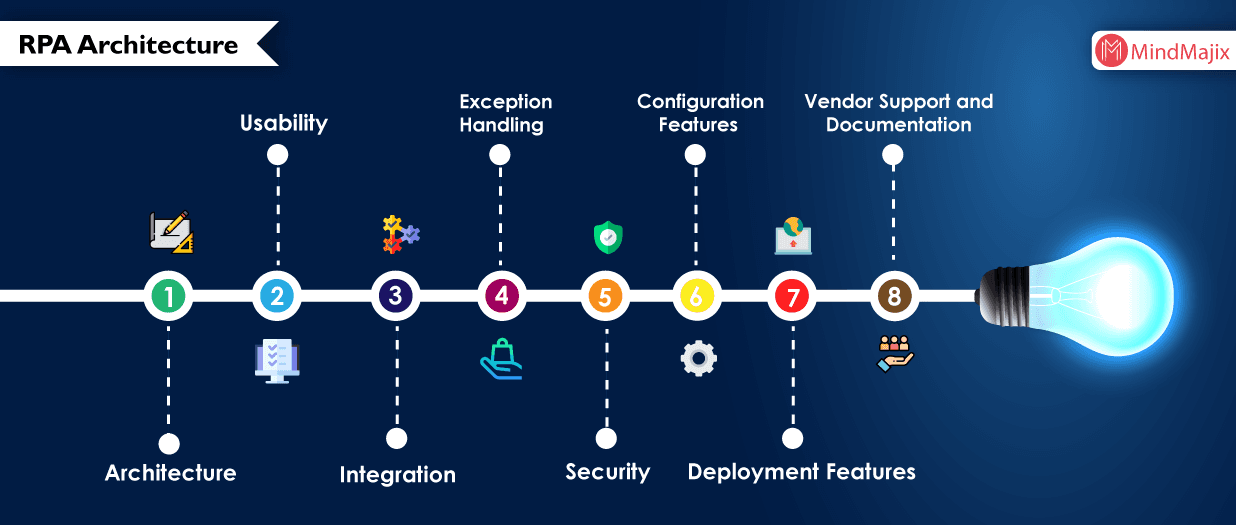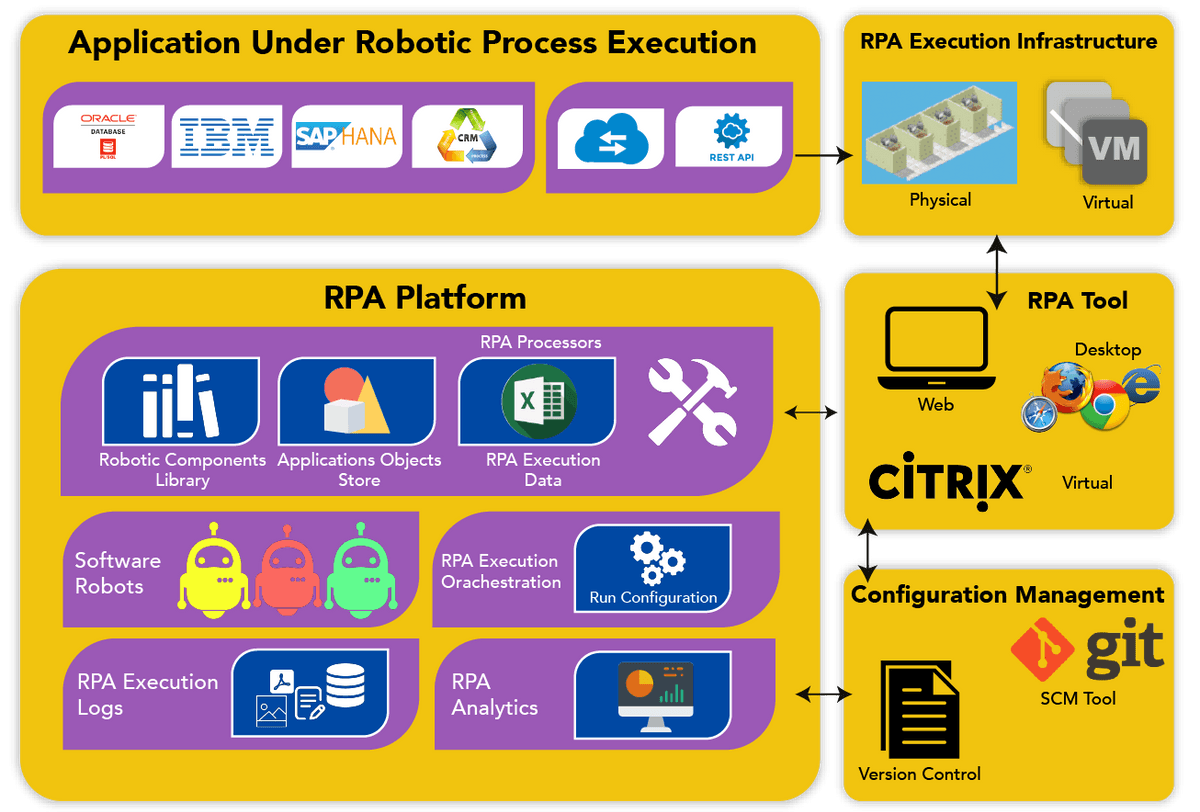- 30 Robotic Process Automation (RPA) Examples
- NICE Actimize RPA Interview Questions
- Automation Anywhere Interview Questions
- Automation Anywhere Tutorial
- Blue Coat Interview Questions
- Blue Prism Architecture
- Blue Prism Certification Guide 2024
- Blue Prism Interview Questions
- Blue Prism Process Studio
- Blue Prism Tutorial
- Blue Prism Version 6
- Blue Prism vs Automation Anywhere
- Blue Prism Vs OpenSpan
- Blue Prism Vs UiPath
- BlueCat Interview Questions
- Career Scope in RPA
- RPA Vs BPM - Major Differences
- Open Source RPA Tools
- Enterprise Robotic Process Automation
- Role of Blue Prism in RPA
- RPA Implementation Challenges
- RPA Interview Questions
- RPA Statistics
- RPA Tools Comparison
- RPA Tutorial
- RPA Use Cases - Case Studies
- UiPath Interview Questions
- UiPath Introduction
- UiPath Tutorial
- What is Robotic Process Automation?
- WorkFusion Interview Questions
- Different Types of Automation
- Introducing Robotic Process Automation
- Kofax Interview Questions for Beginners
- OpenSpan Interview Questions
- Top 10 Reasons To Learn Robotic Process Automation
- RPA vs Selenium - Which one is better?
- How to install UiPath
In this article, we will take a look at what Robotic Process Management(RPA) is and focus on its architecture. This article will target defining all the nitty-gritty details of what makes a system an RPA, and along with it, we will understand the architecture using which such software can be built. With no further delay, let us get started with the same.
| Table of Contents - RPA Architecture |
What is RPA?
Let's start by discussing what RPA is all about.
RPA is a technology, which allows anyone today to configure computer software or a robot for emulating and integrating human actions and interacting with digital systems for executing a business process.
RPA robots, utilizing the user interface, capture data like humans do and manipulate applications. They interpret, communicate and trigger responses with other systems in order to perform a wide variety of repetitive tasks. RPA robot never sleeps, makes zero mistakes, and also costs less than an employee.
| If you would like to Enrich your career with an RPA-certified professional, then visit MindMajix - A Global online training platform: “RPA Online Course” Course. This course will help you to achieve excellence in this domain. |
One of the most challenging decisions that Organizations need to go through is deciding the ideal toolset that they may apply to their implementation of RPA.
The factors discussed below will make sure that you understand your RPA tool and its architecture better. To get better insights into the RPA tool and its architecture, we need to understand the following essential aspects which make one RPA tool:

RPA Architecture
RPA architecture is the most critical factor that needs to be analyzed. But for the time being, the essential element that needs to be understood well is the architecture of the particular product. This also helps in understanding the implications of where it should not be used.
1. Usability
Usability is the most important factor that plays a significant role in the decision-making as well, and for an automation tool, usability should be even more perfect as there is a limited number of steps for configuration concerns. It makes the overall configuration process and the administration process more efficient if it is easier to understand by others. The more accessible software can ensure quicker scalability, ease of deployment, and higher levels of adoption by the customers.
2. Integration
An ideal RPA tool should be able to integrate with various other systems and technologies that might be deployed in an organization’s business processing. The stronger integration capabilities, the better and robust automation is achieved by them.
3. Exception Handling
An effective situation or scenario handling is expected out of an intelligent RPA tool and also requires it to refer to the subject matter experts where there is a judgment required or a manual activity is required. This indirectly means that error handling during automation should be handled more easily, and these should also be resolved automatically. If this is not achievable, these scenarios will be audited for inconsistencies in the RPA solution. With stable exception handling, the orchestration of automation in the workplace can operate smoothly and reliably.
4. Security
RPA solutions will have their hands on the sensitive data of an organization when an RPA solution is deployed there. And as part of this, there should not be an underestimate of the security features and measures that are quintessential of an automation toolkit. Based on each product, there might be a different way of handling such scenarios, but finding the right solution in your case is an essential part of this activity.
5. Configuration Features
Every RPA application holds a feature designed in specific to accelerate and also to simplify the editing of the configuration all the time. This ensures that the effective deployment of automation and also adds a lot of support towards building the required internal capabilities. Each RPA tool has its arsenal of configuration tools tailored specifically to address these configuration management challenges.
6. Deployment Features
(a) Deployment is only when the configuration and testing guidelines are all crossed.
This includes the features like rolling out releases across machines, handle environment-specific variables, provision of security controls for live environment deployments. Some businesses call for specific deployment scenarios where a powerful deployment toolset is always appreciated.
(b) Vendor Support and Documentation
Stronger the support from the Vendor of a particular RPA tool, the better the resources which facilitate the deployment. The maturity of the support organizations differs broadly as many key players have their presence in the market already and also the new budding enterprises who want to make their presence felt in this industry.
No specific RPA tool can be coined as the perfect fit for every process of the organization. Hence the hurdle of selecting the best RPA tool is mostly close to the requirements that you require and the provision that these tools provide. The closest match is what you can proceed with the next set of formalities before making the purchase.
| Related Article: RPA Tutorial for Beginners |
RPA Solution Architecture
Looking at the above details, you should be able to decide the importance of the architecture of any given RPA tool. To understand this in detail, let us get into the specifics of the RPA tool’s architecture. The following block diagram gives you a brief depiction of a typical RPA solution and also its architecture. By the very first look, you can make yourself realize that it is not a single tool, but is a combination of various tools, platforms, and also various infrastructure elements to form a complete RPA tool or a solution. Let us now take a more in-depth look at the high-level details of each of these blocks in the solution architecture given below:

1. Applications under Robotic Process Execution
RPA is well suited for enterprises and enterprise applications like ERP solutions (For example, SAP, Siebel, or massive data processing or records processing applications like Mainframes). Most of these applications are data-centric and also data-intensive with loads and loads of setup and repetitive process activities.
2. RPA Tools
Most of the critical capabilities that are expected to be available in any of the RPA tools are given below:
- The ability to automate a variety of application environments such as Web, Desktop, and Citrix environments.
- The ability to develop software robots that understand by recordings, configuring, and also enhancing these with programming logic (For example, loops and conditions).
- To be able to build reusable components which can further be applied to multiple robots, ensuring modularity and also faster development and also at the same time easier maintenance.
- To be able to build shared application UI object stores and also object repositories containing object locators
- The ability to read and write from/to various data sources while executing these software robots
3. RPA Platform
RPA in the cloud always acts as a shared repository to ensure the storage of all the software robots and also the RPA based resources using the tool. These RPA assets can further be divided across software robots (as repeatable sub-processes) libraries. Scheduling, Distributing, and Monitoring the execution of software robots are the features and capabilities provided by an RPA platform. Given all the information available about RPA assets and executions, the RPA platform further provides the ability to develop meaningful analytics about your software robots and their execution statistics.
4. RPA Execution Infrastructure
RPA execution infrastructure can sometimes be a bank of parallel physical or virtual lab machines, which can be controlled based on usage patterns. Scaling up or down the number of machines in parallel to achieve the task of automation can also be done, and this can be left unattended for as long as you like (as this requires no further human interaction or intervention).
5. Configuration Management
Configuration management is needed for versioning of RPA assets as the underlying application on which software robots are developed may continuously be updated to introduce newer versions, and so would the RPA assets and software robots. Also, as you scale up, RPA implementation efforts and multiple members in your team are developing RPA assets at the same time, and given that there are assets that are shareable and reusable across different software robots, it is evident that source code management capabilities are needed to allow branching and merging of RPA assets.
The diagram above accentuates the understanding that one has over RPA to the next level, providing a better depiction of the RPA tool as a layered design and also explains every layer in the RPA tool’s architecture. The benefits of each of these layers are also taken care of in the diagram, which also accentuates the already existing understanding of the software architecture. This also goes about telling that RPA is not just a single tool that we talk about, but it is a combination of various layers of applications and tools that come together to make this whole system and the architecture.
The depiction is how an RPA solution can always be fed on the feedback, to make the automation model more efficient. The four stages of an application where an RPA tool has been educated to perform a certain number of mundane, monotonous rule-based, repetitive tasks. Once the software robots are well educated, you may want to consult your business users on any specific modifications to the already covered business scenarios. Once the consultation process is concluded, you execute the automation model to ensure your automation is always running and in turn, the tasks that are configured via this automation are performed.
On a certain number of successful execution of these software robots, you perform a retrospection to understand and also identify critical areas where there can be better suggestions implemented to perform these tasks in an even more efficient and effective way. The final goal of this RPA model is to achieve the best-suited business automation model that suits the business requirements and needs.
6. Further Considerations
Many RPA vendors provide RPA tools, platforms, and infrastructure either as a single unified solution or as separate solutions. It may be an excellent option to buy most of these offerings from the same vendor for better integration. If you are planning to use the free RPA tool, you may not get a fully-featured RPA platform and execution infrastructure capabilities, but you get something at no cost.
There isn’t a tool-agnostic RPA platform available at the moment; it may be a good idea that such a product is made available in the market in the future by an existing RPA vendor or service provider. Look for configuration management capabilities in the RPA tool and RPA platform you choose. This may not be a problem early days, but as you scale up this is very much a desirable feature.
| Frequently Asked RPA Interview Questions and Answers |
Conclusion
In this article, we have discussed what RPA is and RPA architecture. We have taken it a step further and also discussed a bit on how we can go about implementing RPA as well. Extending the discussion, we have also tried to get better insights into what different constituents are required to achieve a successful RPA as well.
Hope this article was clear enough to provide the required understanding of RPA and also have imbibed the most important details about it. If you have any further questions or if you have any additional feedback on this article, please comment with your thoughts.
If you are interested to learn RPA and build a career in Automation? Then check out our RPA Certification Training Course at your near Cities
RPA Training Hyderabad, RPA Training Bangalore, RPA Training Pune, RPA Training Chennai, RPA Training Mumbai
These courses are incorporated with Live instructor-led training, Industry Use cases, and hands-on live projects. This training program will make you an expert in RPA and help you to achieve your dream job.
| Explore RPA Sample Resumes! Download & Edit, Get Noticed by Top Employers! |
Learn RPA Tools From Mindmajix:
| Automation Anywhere | Blue Prism |
| UiPath | WorkFusion |
| Kofax | OpenSpan by Pegasystems |
| Kofax Capture | Winshuttle |
| Kryon Systems | Softomotive |
| Kapow | Thoughtonomy |
| NICE Actimize RPA | and more... |
 On-Job Support Service
On-Job Support Service
Online Work Support for your on-job roles.

Our work-support plans provide precise options as per your project tasks. Whether you are a newbie or an experienced professional seeking assistance in completing project tasks, we are here with the following plans to meet your custom needs:
- Pay Per Hour
- Pay Per Week
- Monthly
| Name | Dates | |
|---|---|---|
| RPA Training | Dec 13 to Dec 28 | View Details |
| RPA Training | Dec 16 to Dec 31 | View Details |
| RPA Training | Dec 20 to Jan 04 | View Details |
| RPA Training | Dec 23 to Jan 07 | View Details |

Suneel, a Technology Architect with a decade of experience in various tech verticals like BPM, BAM, RPA, cybersecurity, cloud computing, cloud integration, software development, MERN Stack, and containerization (Kubernetes) apps, is dedicated to simplifying complex IT concepts in his articles with examples. Suneel's writing offers clear and engaging insights, making IT accessible to every tech enthusiast and career aspirant. His passion for technology and writing guides you with the latest innovations and technologies in his expertise. You can reach Suneel on LinkedIn and Twitter.















